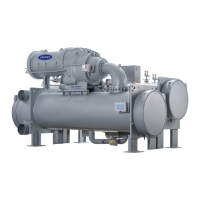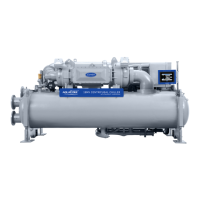94
from concentration of refrigerant to keep false readings to a
minimum. Before making any necessary repairs to a leak,
transfer all refrigerant from the leaking vessel.
Leak Rate — It is recommended by ASHRAE that chillers
be taken off line immediately and repaired if the refrigerant
leak rate for the entire chiller is more than 10% of the operating
refrigerant charge per year.
In addition, Carrier recommends that leaks totalling less
than the above rate but more than a rate of 0.1% of the total
charge per year should be repaired during annual maintenance
or whenever the refrigerant is transferred for other service
work.
Test After Service, Repair, or Major Leak — If all
the refrigerant has been lost or if the chiller has been opened
for service, the chiller or the affected vessels must be pressure
tested and leak tested. Refer to the Leak Test Chiller section to
perform a leak test.
TESTING WITH REFRIGERANT TRACER — Use an en-
vironmentally acceptable refrigerant as a tracer for leak test
procedures. Use dry nitrogen to raise the machine pressure to
leak testing levels.
TESTING WITHOUT REFRIGERANT TRACER — An-
other method of leak testing is to pressurize with nitrogen only
and to use a soap bubble solution or an ultrasonic leak detector
to determine if leaks are present.
TO PRESSURIZE WITH DRY NITROGEN
NOTE: Pressurizing with dry nitrogen for leak testing should
not be done if the full refrigerant charge is in the vessel
because purging the nitrogen is very difficult.
1. Connect a copper tube from the pressure regulator on the
cylinder to the refrigerant charging valve. Never apply
full cylinder pressure to the pressurizing line. Follow the
listed sequence.
2. Open the charging valve fully.
3. Slowly open the cylinder regulating valve.
4. Observe the pressure gage on the chiller and close the
regulating valve when the pressure reaches test level. Do
not exceed 140 psig (965 kPa).
5. Close the charging valve on the chiller. Remove the cop-
per tube if it is no longer required.
Repair the Leak, Retest, and Apply Standing
Vacuum Test —
After pressurizing the chiller, test for
leaks with an electronic halide leak detector, soap bubble solu-
tion, or an ultrasonic leak detector. Bring the chiller back to at-
mospheric pressure, repair any leaks found, and retest.
After retesting and finding no leaks, apply a standing vacu-
um test. Then dehydrate the chiller. Refer to the Standing Vacu-
um Test and Chiller Dehydration section (page 71) in the Be-
fore Initial Start-Up section.
Checking Guide Vane Linkage — When the chiller
is off, the guide vanes are closed and the actuator mechanism is
in the position shown in Fig. 49. Slack in the guide vane actua-
tor’s drive chain can only be removed with the guide vane
actuator fully closed and the chiller shut down. Complete the
following steps to adjust chain tension and position:
1. Remove the two set screws in the guide vane actuator
sprocket.
2. Loosen the guide vane actuator’s holddown bolts.
3. Pull the guide vane actuator away from the suction hous-
ing along the slotted holes in the actuator bracket.
4. Rotate the guide vane sprocket fully clockwise and
spot-drill the guide vane actuator shaft. Spot-drilling is
necessary when the guide vane actuator sprocket set
screws on the guide vane actuator shaft need to be
re-seated. (Remember: Spot-drill and tighten the first set
screw before spot-drilling for the second set screw.)
WARNING
HFC-134a should not be mixed with air or oxygen and
pressurized for leak testing. In general, this refrigerant
should not be present with high concentrations of air or
oxygen above atmospheric pressures, because the mixture
can undergo combustion.
CHAIN
GUARD
DRIVE
CHAIN
GUIDE VANE
ACTUATOR
SPROCKET
SET
SCREWS
GUIDE VANE
ACTUATOR
SUCTION
HOUSING
GUIDE VANE
ACTUATOR
SHAFT
ACTUATOR
BRACKET
HOLDDOWN
BOLTS (3)
GUIDE VANE
SHAFT
GUIDE VANE
SPROCKET
O
P
E
N
C
L
O
S
E
Fig. 49 — Guide Vane Actuator Linkage
a19-1731

